Patterned on Nature
If you have fish, you want to see them. Most colourful fish, however, prefer to remain invisible in dense clouds of mud. Their intensive raking of the sludge on the ground continually releases nutrients into the water that fertilise algae. A good filter therefore has to collect these mud particles as well as the tiny, mostly unicellular algae.
|
 NaturaGart Underwater Park: We let algae proliferate as a test. |
 14 days later the 300 cubic metres of pond water are clear again. |
What can be expected
A filter is not used to eliminate 10 year old layers of mud - it is better to do that differently.
Filters should prevent a pond from silting up from a very early stage. The water remains clear because sediment is constantly being removed from the ground. |
 What many ponds look like: Brown-grey-green water is a mixture of sediment and algae. |
 When short strings of algae get inflated with oxygen they drift to the surface - no skimmer can handle this. |
 Later, thread algae begin to grow. They either sit on the ground or swim on the surface - unreachable for the filter. |
 In many ponds the water is milky-grey. A filter normally handles such a bloom of bacteria quite well. |
 Left: In shallow ponds the ground is easily visible. Right: In deeper ponds the longer line of sight is obstructed by more particles that hamper visibility. Water in deeper ponds therefore has to be cleaner in order to be perceived as equally clear. |
Combined Pore Size
Coarse filtering foams let too many particles pass through, in the very fine ones the surface quickly clogs up. In a NaturaGart filter the proportion of different pore sizes can be changed depending on the season: More coarse filter in Spring, more fine filter in Summer. This way the filtering media fill up with mud and algae evenly. |
 Very coarse green filtering foam retains large particles. |
 The last step is a fine blue foam with 45ppi (pores per inch). |
Modular Construction
Most filters are built for precisely determined sizes of pond and fish populations. When the fish grow or multiply or when the pond is made bigger, you have to buy the next size filter. The NaturaGart filter is a system of building blocks that can be incrementally upgraded. This means that you investment remains intact. |
 The coarse filter is useful for ponds with large fish populations. Water flows into a distributing chamber and trickles over a grating of variable opening size. All large particles like thread algae etc. are deposited here. |
 This horizontal filter HF-26 has four different filtering foams. The water flows into a chamber and then passes through the foam elements. When an element clogs up, the water overflows it and into the next one. |
Any Combination Possible
The aim is not to let large particles get to the fine filters.
Coarse filters therefore extend maintenance intervals in ponds with many fish a great deal.
The horizontal filter HF-26 can absorb up to 8 kilos of mud. The rest of the fine particles get caught in the organic mats of the vertical filter VF-8. |
 The vertical filter VF-8 is normally equipped with an organic mat with very fine pores. It is later composted because it is near impossible to clean such fine filtering media properly. |
 Alternatively the VF-8 can also be equipped with very fine filtering foams of 60ppi (pores per inch). They are twice as fine as regular filters. |
 Another application example for VF-8: Water trickles through an oxy-foam and is enriched with oxygen. Specialised bacteria take care of nitrogen extraction. |
 |
 The base module BM-13 contains oxidising foam for nitrogen transformation. After that water flows through a 70mm wide drain. |
How You Can Combine:
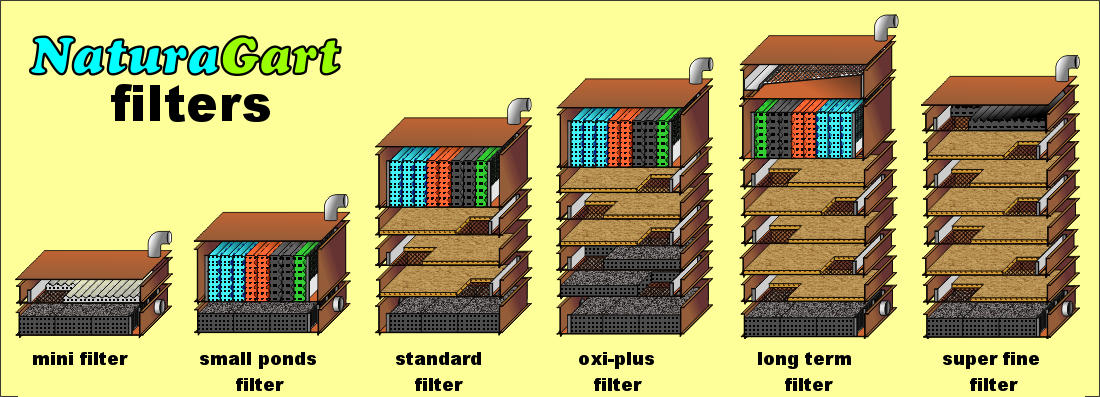
Depending on pond usage and size, the modules allow for different filter assemblies.
|
For Smallier Ponds
Up to 3m³ the mini filter is sufficient. As a standard it comes equipped with fine filtering foam.
The small-ponds-filter (up to 20m³) retains the large particles with its foam elements, but cannot filter out the very fine particles. Results are normally satisfactory, though, due to little depth. The standard filter (up to 50m³) additionally retains fine particles in 3 VF-8 modules.
|
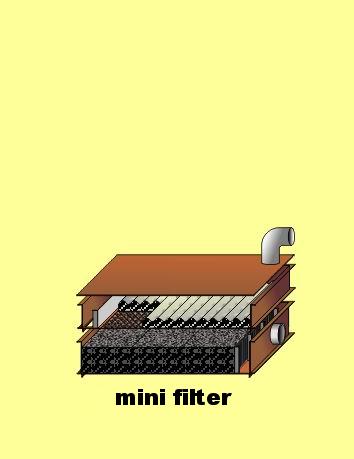
For Weak Pumps in Small Ponds. |
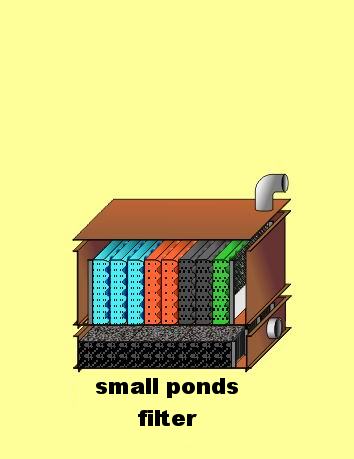
For 50-70cm deep ponds.
|
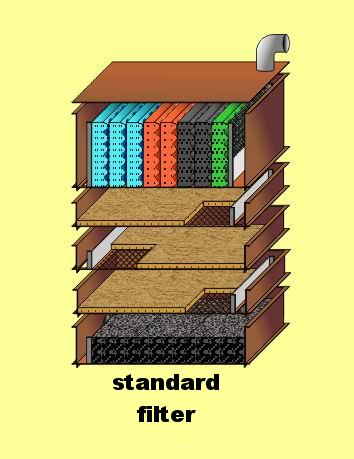
Ideal for most ponds, a filter up to 50m³.
|
For Special Applications
Where in ponds with few plants and large fish populations the risk of higher concentrations of ammonia and nitrites exists, the VF-8 modules can be equipped with oxidising foams. Please note, however, that while this method can stabilise a problematic situation, it cannot substitute nitrogen extraction through plants.
Other combinations allow for longer service life or reduced maintenance.
|
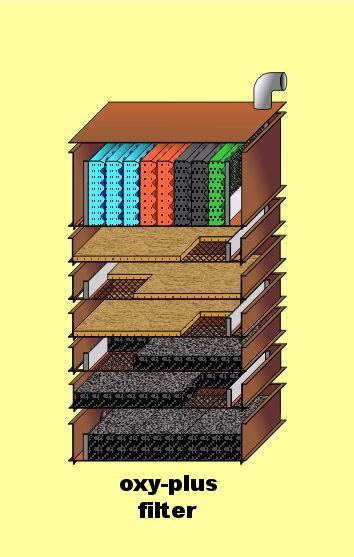
The oxy-modules have large surface areas for bacterial colonisation.
|
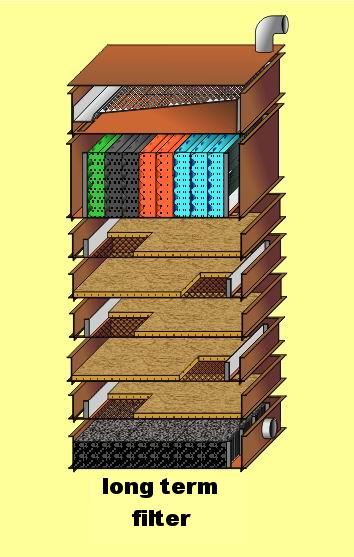
The added coarse filter increases service life.
|
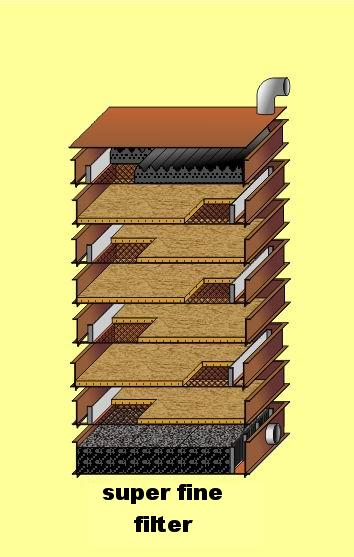
Instead of cleaning the filtering foam, just change the bio-degradable mat.
|
Water Flow
Water enters the topmost module through the lid and has to pass the filtration media along its way. Should these be clogged up, the water will run through emergency overflows and return to the pond without having been thoroughly cleaned.
The filtration modules are designed for a maximum of 70 litres per minute (about 4m³ per hour). If this value is exceeded another filter has to be installed.
|
 Water has to flow horizontally through the filtering foams. Through holes it then runs onto the organic mats on the bottom sieve. |
 In large installations a number of filters are set up in parallel. In our largest installation we treat about 1,000m³ per day. |
Product Comparison
Foam Index:
This value shows how much filtering volume you get per Euro. NaturaGart filters can do up to 300, while other filters barely reach 10% of this value, because designer housings and expensive sales outlets drive prices up. The mid-range lies at about 150.
|
Operating Costs
Often the filtration media used are too coarse and hence the pumps are too strong. NaturaGart filters consume about 0.03KWh per m³ per day, while many other installations use up to three times more!
Assumption: A standard filter in a 50m³ pond at 1m head and 15 hours of operation per day.
|
Investment Relation
The investment in filtration technology costs about 10 Euros per m³ with NaturaGart. Many filtration systems cost twice as much, some even four times. Expensive housings and over dimensioned pumps drive costs up. Assumption: A standard filter in a 50 cubic metre pond, pump AM 6000.
|
Investment Protection
Fish grow and the old filter isn't sufficient any more. The NaturaGart system grows along. In small, inexpensive increments, because often one additional module is enough.
|
Minimal Risk
Frost or a fallen branch often mean total loss with some systems. The modular concept of NaturaGart filters limits such risks. The system will automatically evacuate in case of frost.
|
Baby-Well
Young fish, dragonfly larvae and tadpoles often survive the journey through the pump only to then die in the filter. HF-26 has a chamber to collect these passengers. |
Find the prices for the filters
at the NaturaGart Shop |
|
|
|
























